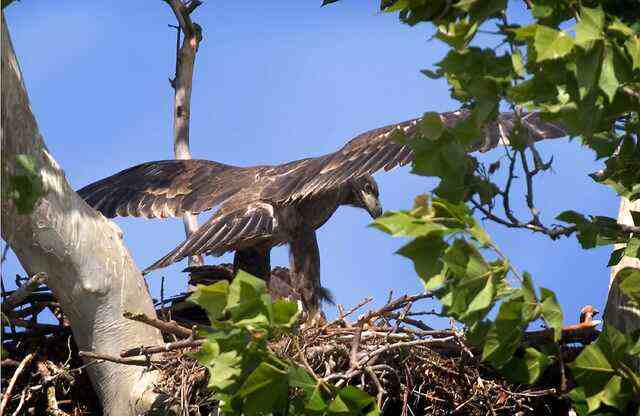This question is of great interest to those who study the behavior and ecology of these majestic birds. Understanding the timing of eagle mating in Florida is crucial for conservation efforts and for gaining insight into the intricate complexities of their life cycle.
In this article, we will delve into the fascinating world of eagle mating, exploring the factors that influence their reproductive patterns and the importance of this process for the health of the ecosystem.
By examining the nesting habits, habitat selection, and conservation efforts surrounding Florida eagles, we can gain a deeper understanding of their unique mating behaviors.
Through a scientific and objective lens, we will explore the mating season of Florida eagles and how it is influenced by various environmental and biological factors.
Join us on this journey to uncover the secrets of when eagles mate in Florida, and discover the beauty and wonder of these magnificent creatures.
Table of Contents
- 1 Key Takeaways
- 2 When Do Eagles Mate In Florida
- 3 Overview of Eagle Species in Florida
- 4 Understanding Eagle Mating Behavior
- 5 Mating Season for Florida Eagles
- 6 Factors Influencing Eagle Mating Patterns
- 7 Nesting Habits and Habitat Selection
- 8 Observing Eagles in the Wild
- 9 Threats to Eagle Reproduction
- 10 Conservation Efforts for Florida Eagles
- 11 Importance of Eagle Mating for Ecosystem Health
- 12 The Life Cycle of Florida Eagles
- 13 Conclusion and Future Outlook for Florida Eagles
- 14 Frequently Asked Questions
- 14.1 What is the average number of eggs laid by Florida eagles during the mating season?
- 14.2 How long does the courtship period typically last for Florida eagles?
- 14.3 Are there any specific behaviors or displays that eagles engage in during the mating season?
- 14.4 How do environmental factors, such as weather conditions, affect eagle mating patterns in Florida?
- 14.5 Are there any specific challenges or threats to eagle mating in Florida that are not mentioned in the article?
- 15 Author
Key Takeaways
- Eagles mating in Florida is of great interest to researchers studying their behavior and ecology.
- The timing of eagle mating is crucial for conservation efforts and gaining insight into their life cycle.
- Factors such as food availability, weather conditions, and habitat suitability influence eagle mating patterns.
- The prime time to witness eagle mating in Florida is during the winter months, from December to February.
When Do Eagles Mate In Florida
Eagles typically mate in Florida from late October to early January, with nesting activity starting one to three months before the female lays eggs. However, the exact timing can vary depending on the location and weather conditions.
Overview of Eagle Species in Florida
Florida is home to a diverse range of eagle species, making it an ideal location for studying and observing these majestic birds.
The state boasts a significant eagle population, with two main species being the bald eagle (Haliaeetus leucocephalus) and the golden eagle (Aquila chrysaetos).
Both species have distinct ecological impacts on the region. The bald eagle, for example, plays a vital role in controlling populations of small mammals and fish, thus contributing to the overall balance of the ecosystem.
The golden eagle, on the other hand, primarily preys on larger mammals, such as rabbits and ground squirrels, which helps regulate their populations.
Understanding the eagle mating behavior is crucial for comprehending their overall ecological impact.
By studying their reproductive patterns and habits, researchers can gain valuable insights into the population dynamics and conservation strategies for these magnificent birds.
Understanding Eagle Mating Behavior
This discussion will focus on two important aspects of eagle mating behavior: courtship displays and pair bonding, and nesting and reproduction.
Courtship displays are elaborate behaviors performed by eagles to attract a mate and establish a strong pair bond. These displays often involve aerial acrobatics, calling, and mutual gift-giving.
Once a pair bond is formed, eagles will proceed to build a nest together and engage in reproductive activities, including copulation and egg-laying.
Understanding these aspects of eagle mating behavior is crucial for studying their reproductive success and population dynamics.
Courtship Displays and Pair Bonding
Courtship displays and pair bonding in eagles are essential for successful reproduction, as demonstrated by a study where male eagles engage in elaborate aerial displays to attract potential mates.
These courtship rituals often involve acrobatic flights, where the male eagle performs breathtaking aerial maneuvers, such as loop-the-loops and barrel rolls, to showcase his strength, agility, and genetic fitness.
These displays serve as a visual spectacle, allowing the male eagle to demonstrate his suitability as a mate to the female.
Once a pair bond is formed, the eagles engage in behaviors that strengthen their relationship, such as mutual preening and nest building.
Courtship displays and pair bonding are integral components of eagle mating behavior, ensuring the establishment of a strong breeding pair dynamic.
These behaviors transition seamlessly into the subsequent section about nesting and reproduction, where the eagles continue their journey towards successful reproduction.
Nesting and Reproduction
Nesting and reproduction in eagles involve the construction of large and sturdy nests, often located in tall trees or on cliff ledges, providing a safe and secure environment for the development of their offspring.
Eagle reproductive behavior is characterized by a strong pair bond between the male and female, which is established through courtship displays and mutual territorial defense.
The nesting ecology of eagles is fascinating, with several key aspects to consider:
- Nest Construction: Eagles build their nests using sticks, twigs, and other materials, reinforcing them with softer materials such as grass and moss. These nests can reach impressive sizes, sometimes measuring several feet in diameter.
- Nest Site Selection: Eagles prefer nesting sites that provide a clear view of the surrounding area, enabling them to detect potential threats and sources of food. They often choose tall trees or cliff ledges, which offer protection and stability.
- Nest Reuse: Eagles tend to reuse their nests year after year, adding new materials each breeding season. This behavior helps them save time and energy, as well as maintain a familiar and reliable nesting site.
Understanding the nesting ecology of eagles provides valuable insights into their reproductive strategies and overall population dynamics.
Transitioning to the next section, the timing of these nesting activities coincides with the mating season for Florida eagles.
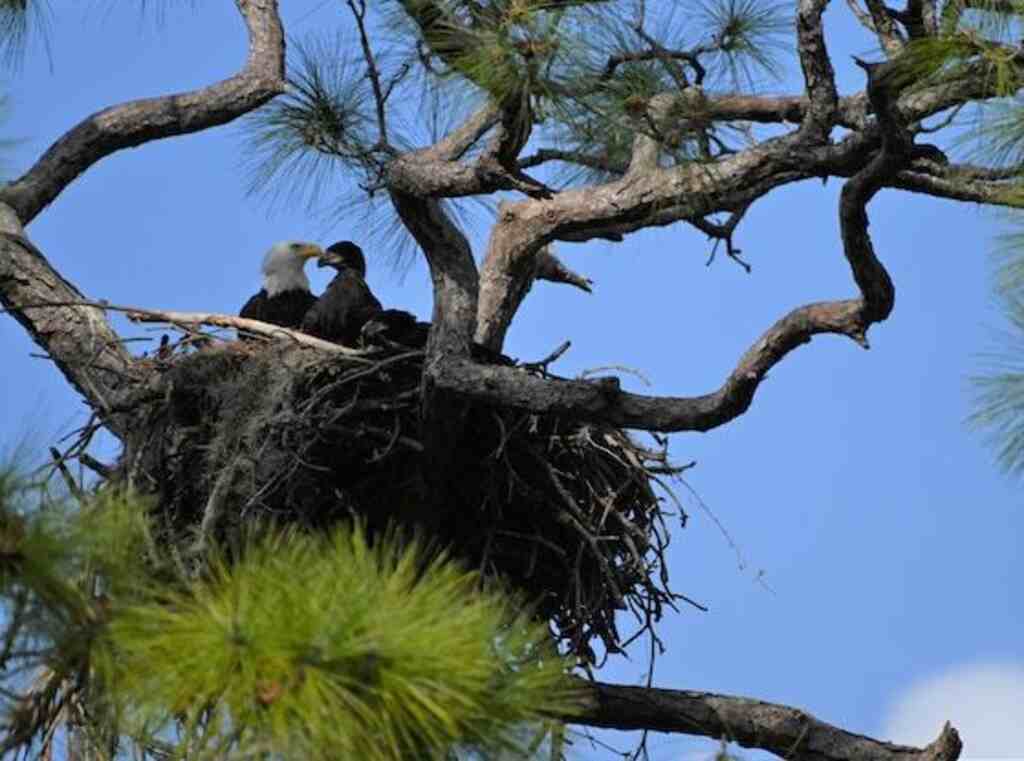
Mating Season for Florida Eagles
During the breeding season, Florida eagles engage in a delicate dance of courtship, their soaring flights and graceful dives mesmerizing observers with a ballet of love in the skies.
Eagle behavior during this time is marked by various displays, including calling, aerial displays, and mutual soaring. These behaviors serve to establish and strengthen pair bonds between the eagles.
Courtship feeding is also a common behavior during the breeding season, where the male brings food to the female as a display of his ability to provide for their future offspring.
The breeding habits of Florida eagles are influenced by factors such as food availability, weather conditions, and habitat suitability. These factors can affect the timing and success of mating.
Transitioning into the subsequent section about factors influencing eagle mating patterns, exploring these factors can provide valuable insights into understanding the complexities of eagle reproduction.
Factors Influencing Eagle Mating Patterns
Factors such as food availability, weather conditions, and habitat suitability significantly influence the timing and success of mating for Florida eagles.
The influence of climate on eagle mating is particularly noteworthy, as eagles rely on specific weather patterns for successful reproduction.
Changes in temperature, precipitation, and wind patterns can disrupt the timing of mating behaviors, potentially leading to reduced reproductive success.
Additionally, habitat destruction poses a significant threat to eagle reproduction in Florida.
Loss of suitable nesting sites and disruption of foraging areas can limit the availability of resources necessary for successful mating.
Conservation efforts aimed at preserving and restoring eagle habitats are crucial for ensuring the long-term reproductive success of these majestic birds.
Transitioning into the subsequent section about nesting habits and habitat selection, understanding these factors is essential for comprehending the intricacies of eagle reproduction.
Nesting Habits and Habitat Selection
Habitat suitability heavily influences the choice of nesting sites for eagles, highlighting the importance of appropriate environmental conditions for successful reproduction. Eagles exhibit specific nesting habits and carefully select habitats that provide the necessary resources for their young.
Here are four key factors that influence eagle nesting habits and habitat selection:
- Elevation: Eagles prefer nesting at higher elevations, such as tall trees or cliffs, which offer a vantage point for hunting and protection from predators.
- Nest Structure: Eagles build large nests, called eyries, using sticks and other materials. They often return to the same nest each year, adding to its size and reinforcing its structure.
- Proximity to Water: Eagles choose nesting sites near bodies of water, such as lakes or rivers, as they rely on these for food sources, including fish.
- Nesting Territory: Eagles establish and defend a specific territory around their nest, ensuring a sufficient food supply and reducing competition with other eagles.
Understanding these nesting habits and habitat selection is crucial for observing eagles in the wild and studying their behavior.
The subsequent section will focus on the methods used to observe these majestic birds without disturbing their natural behavior.
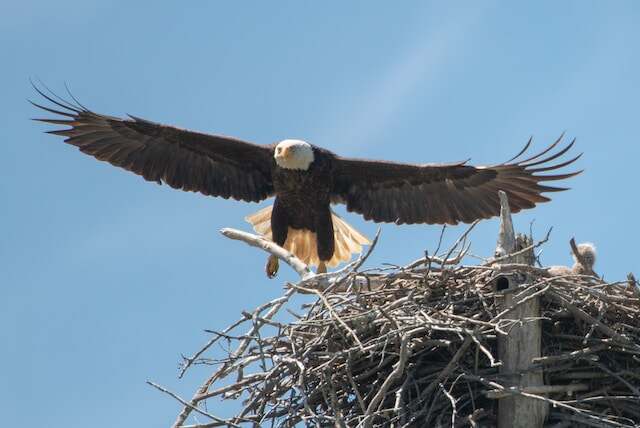
Observing Eagles in the Wild
This discussion will focus on two key points: the best locations for eagle watching in Florida and tips for responsible wildlife observation.
Florida offers several prime locations for eagle watching, including the Everglades, the Apalachicola National Forest, and Lake Kissimmee State Park.
When observing eagles in the wild, it is important to follow guidelines for responsible wildlife observation, such as keeping a safe distance, avoiding disturbance to the birds, and refraining from feeding or baiting them.
Best Locations for Eagle Watching in Florida
The prime locations for eagle watching in Florida offer an ideal environment for observing the mating behaviors of these majestic birds.
The best times to witness eagle mating in Florida are generally during the winter months, from December to February. During this time, eagles are more active and engaged in courtship displays and nest-building activities.
One of the top locations for eagle watching is the Arthur R. Marshall Loxahatchee National Wildlife Refuge, which provides a vast expanse of wetlands and freshwater habitats that attract a large number of eagles.
Another recommended spot is the Honeymoon Island State Park, known for its pristine beaches and coastal habitats that support a healthy population of eagles.
For photography enthusiasts, it is advisable to bring telephoto lenses and capture the eagles from a safe distance without disturbing their natural behavior.
Transitioning into the subsequent section about tips for responsible wildlife observation, it is crucial to maintain a respectful distance and avoid any actions that may disrupt or harm the eagles or their habitat.
Tips for Responsible Wildlife Observation
One crucial aspect of observing wildlife responsibly is maintaining a respectful distance to ensure the safety and well-being of the animals and their environment.
Responsible tourism practices promote ethical wildlife photography, which emphasizes the importance of not disturbing or harassing the animals in any way.
This includes not getting too close to their nests or feeding areas, and not using flash or artificial light sources that may startle or blind them.
It is essential to remember that wildlife observation should be done without interfering with the natural behaviors and habitats of the animals.
By adhering to these guidelines, visitors can enjoy the beauty of eagles and other wildlife while minimizing any negative impact.
Transitioning into the subsequent section about threats to eagle reproduction, it is important to understand the challenges these majestic birds face in their mating and nesting activities.
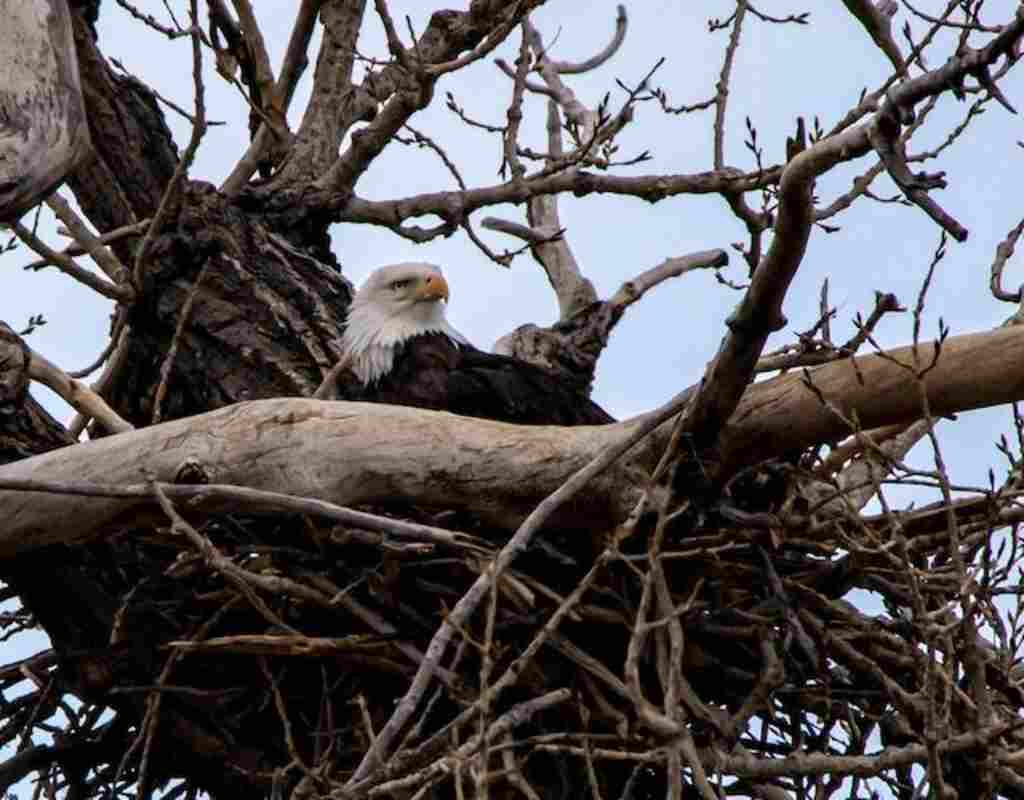
Threats to Eagle Reproduction
Threats to eagle reproduction in Florida include habitat loss, pollution, and human disturbance, all of which can negatively impact the mating behaviors and breeding success of these majestic birds.
Habitat loss is a significant threat to eagle populations, as urbanization and development result in the destruction of nesting sites and foraging areas.
Pollution, such as the release of pesticides and toxins into the environment, can also have detrimental effects on eagle reproduction.
These pollutants can accumulate in the eagles’ food sources and lead to reproductive abnormalities and reduced fertility.
Additionally, human disturbance, such as noise and disturbance near nesting sites, can disrupt courtship displays and cause eagles to abandon their nests.
Climate change is another emerging threat, as it can alter the availability of prey and nesting conditions for eagles.
Conservation efforts for Florida eagles aim to mitigate these threats and ensure the long-term survival of these iconic birds.
Transitioning to the subsequent section on conservation efforts, it is crucial to address measures taken to protect and conserve Florida’s eagle population.
Conservation Efforts for Florida Eagles
Nest monitoring and protection are crucial aspects of conservation efforts for Florida eagles. By closely monitoring eagle nests, researchers can gather valuable information about breeding success, nest occupancy, and population trends.
This data allows conservationists to identify potential threats and implement protective measures to ensure the survival of these majestic birds.
Collaboration with wildlife organizations is also key in conserving Florida eagles.
By working together, these organizations can pool resources, share knowledge and expertise, and coordinate efforts to maximize the impact of conservation initiatives.
This collaborative approach enhances the effectiveness of conservation strategies and promotes the long-term viability of Florida’s eagle population.
Nest Monitoring and Protection
To ensure the well-being of eagles in Florida, monitoring and protecting their nests is of utmost importance. Nest monitoring involves regularly checking the nests to gather data on eagle populations, breeding success, and nesting behavior.
Conservation efforts rely on this information to assess the health of eagle populations and identify potential threats or challenges they may face.
Protection measures include preventing disturbances near the nests, such as restricting access to nesting areas and implementing buffer zones to minimize human disturbance.
Additionally, nest protection may involve installing cameras to monitor nests remotely and deter potential threats.
This proactive approach helps to safeguard eagle populations and promote their successful reproduction.
By collaborating with wildlife organizations and sharing data, conservation efforts can be further enhanced and ensure the long-term survival of these majestic birds.
Collaboration with Wildlife Organizations
Collaboration with wildlife organizations is essential for effective conservation management, as seen in the successful partnership between the state park authorities and a local non-profit organization in California.
This collaboration has allowed for the implementation of various wildlife rehabilitation and citizen science initiatives aimed at protecting and monitoring eagle nests.
Wildlife rehabilitation efforts involve rescuing injured or orphaned eagles, providing them with necessary medical care, and ensuring their successful release back into the wild.
Citizen science initiatives encourage the public to actively participate in data collection, monitoring eagle nests, and reporting any disturbances or threats to their habitat.
By collaborating with wildlife organizations, state park authorities are able to tap into the expertise and resources of these organizations, leading to more effective management and protection of eagle populations.
This partnership showcases the importance of collaborative efforts in conserving and managing wildlife populations.
Transitioning into the subsequent section, understanding the timing of eagle mating in Florida is crucial for assessing the health of the ecosystem.
Importance of Eagle Mating for Ecosystem Health
The mating of eagles is crucial for maintaining a healthy balance within the ecosystem in Florida. The decline in the eagle population has had a significant impact on the food chain.
Eagles play a vital role as top predators, controlling the populations of their prey species and preventing overpopulation. This helps to maintain the biodiversity and stability of the ecosystem.
When eagles mate, they ensure the continuation of their species and contribute to the overall health of the ecosystem.
By producing offspring, eagles help to maintain the delicate balance between predator and prey, regulating the population levels of other animals.
This has a cascading effect on the entire food chain, influencing the abundance and distribution of other species.
Understanding the importance of eagle mating is essential for conservation efforts and the preservation of Florida’s diverse ecosystem.
This understanding sets the stage for exploring the life cycle of Florida eagles.
The Life Cycle of Florida Eagles
An examination of the life cycle of Florida eagles reveals the various stages they go through from hatching to adulthood.
The Florida eagle population experiences an annual breeding season, which typically occurs from October to May.
During this time, eagles engage in courtship displays and build or refurbish nests in preparation for egg-laying.
The female eagle usually lays one to three eggs, which both parents take turns incubating for about 35 days.
Once hatched, the eaglets are initially dependent on their parents for food and protection. They gradually develop their flight feathers and learn to fly, which typically occurs around 10 to 12 weeks of age.
As the young eagles reach maturity, they leave their parents’ territory and establish their own territories.
Understanding the intricacies of the life cycle of Florida eagles is crucial for conservation efforts and ensuring the future well-being of this majestic species.
Transitioning into the subsequent section, the examination of the life cycle provides valuable insights for the conclusion and future outlook for Florida eagles.
Conclusion and Future Outlook for Florida Eagles
The life cycle of Florida eagles is a fascinating process that involves various stages, including nest building, mating, incubation, and fledging. However, it is essential to consider the future outlook for these majestic birds in the face of future challenges.
One significant challenge is the increasing population growth in Florida, which may result in habitat loss and disturbance.
As more human activities encroach upon their natural habitats, it is crucial to implement conservation strategies to ensure the long-term survival of Florida eagles.
Additionally, the population growth may lead to increased competition for resources, which could potentially impact the reproductive success of these birds.
Therefore, it is imperative to monitor and manage their populations carefully to mitigate the negative effects of human activities and ensure a sustainable future for Florida eagles.
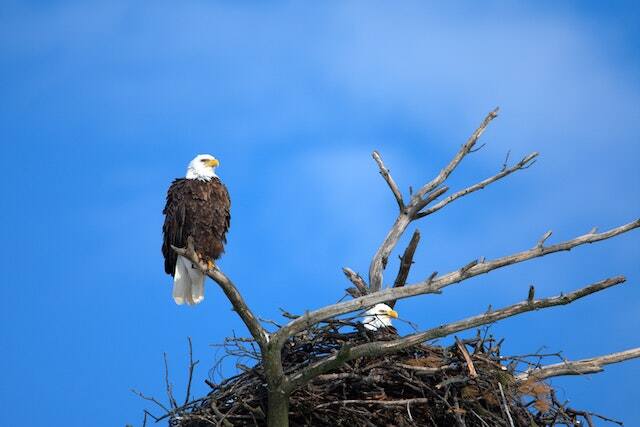
Frequently Asked Questions
What is the average number of eggs laid by Florida eagles during the mating season?
The average number of offspring laid by Florida eagles during the mating season is subject to natural variation. However, eagles generally lay 1-3 eggs per nesting cycle, with 2 eggs being the most common. This nesting behavior ensures the survival of the species.
How long does the courtship period typically last for Florida eagles?
The courtship period in Florida eagles is akin to a graceful dance, characterized by intricate displays and vocalizations. It is an essential behavior that contributes to breeding success and ensures the continuation of their population.
Are there any specific behaviors or displays that eagles engage in during the mating season?
During the mating season, eagles engage in various courtship displays and rituals. These behaviors include aerial displays, nest-building activities, vocalizations, and mutual feeding. These displays serve to establish pair bonds and reinforce the reproductive success of the eagles.
How do environmental factors, such as weather conditions, affect eagle mating patterns in Florida?
The impact of climate change on eagle mating patterns in Florida is an area of concern. Changes in weather conditions can disrupt mating rituals, potentially affecting the reproductive success of eagles in the region.
Are there any specific challenges or threats to eagle mating in Florida that are not mentioned in the article?
Challenges faced by eagles during mating season in Florida include habitat loss, disturbance from human activities, and the impact of climate change. These factors can disrupt mating behaviors and reduce reproductive success. Additionally, human activities such as development and pollution can further threaten eagle populations.



